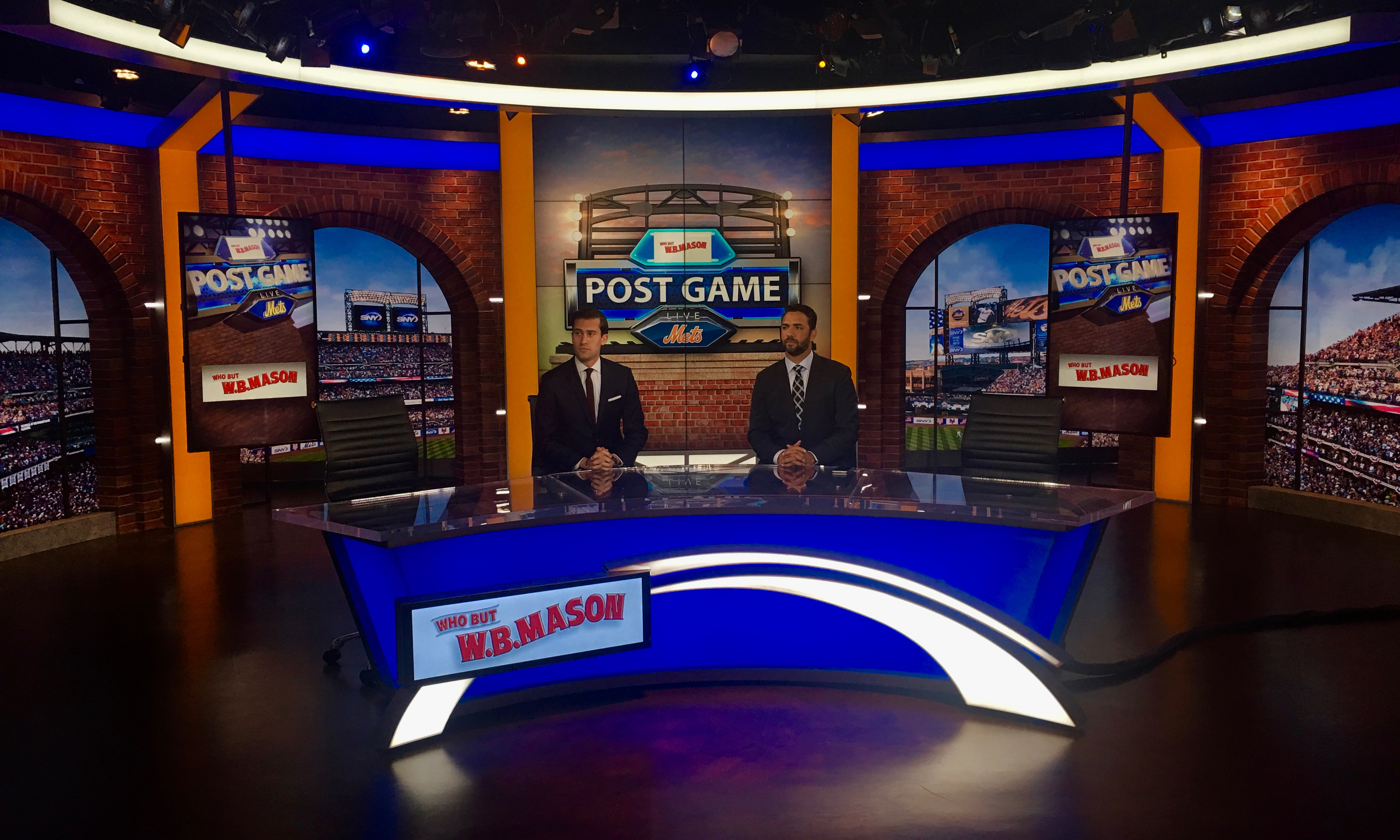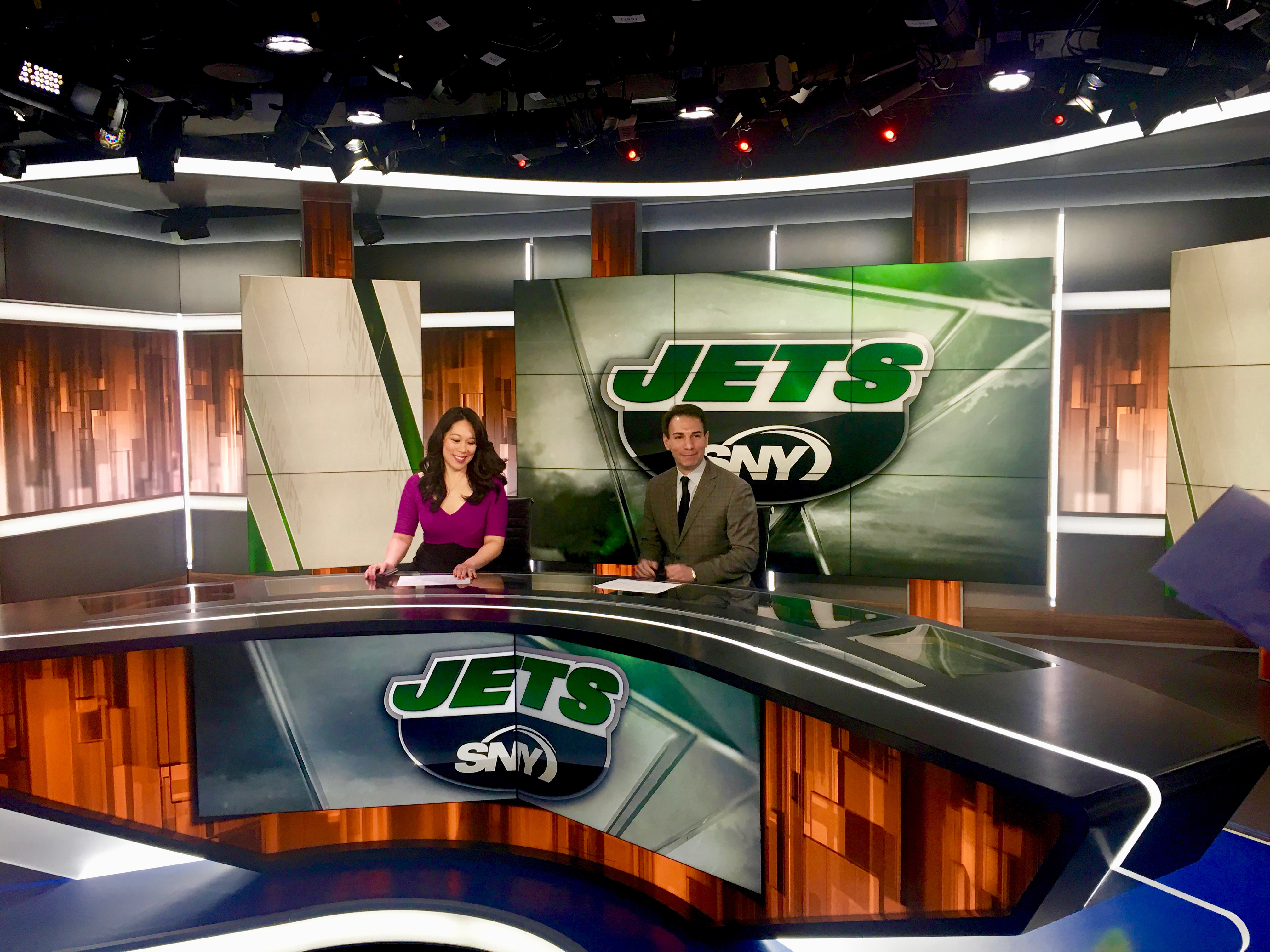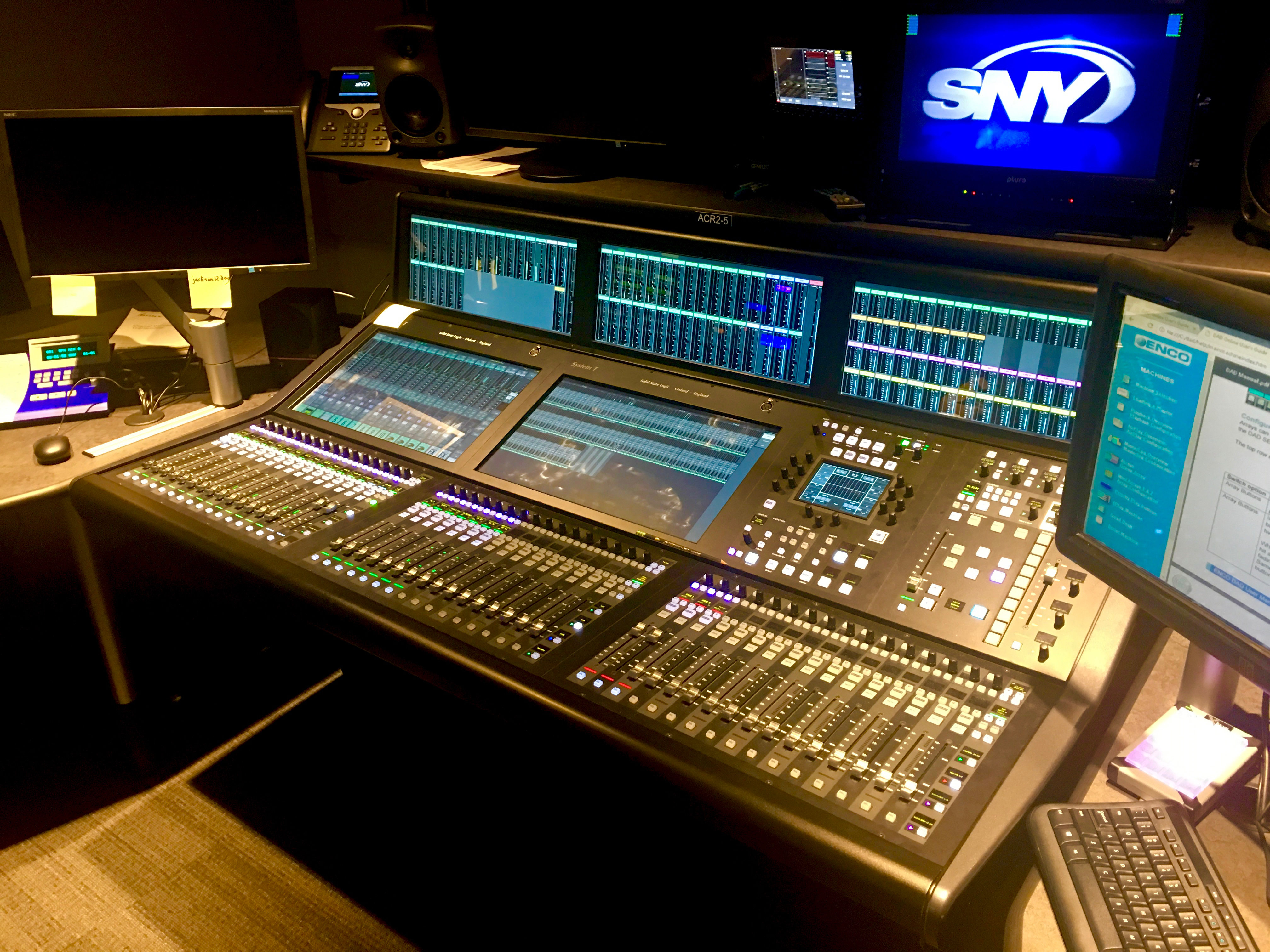SNY’s New Era Begins With Launch of New Manhattan Studios
Downtown facility gives production team more than twice as much space, more creative freedom
Story Highlights
After spending more than a decade on Sixth Avenue, SNY this weekend officially goes on-air from a new home on the 49th and 50th floor of 4 World Trade Center. The new home is a bit further downtown and taps into the vibrancy of downtown Manhattan. It also gives the SNY production team more than twice as much work space and nearly twice as much studio space as it had previously.
“We outgrew that studio 10 years ago,” says Steve Rabb, president, SNY. “We had a graphics department housed in what used to be a dressing room, and we were bursting at the seams. This space affords our production people the space to create great content, and we will be in here for a long time.”
The total space grew from 30,780 sq. ft. to 39,369 sq. ft.; the production space, from 12,840 sq. ft. to 26,856 sq. ft. Studio space is now 3,750 sq. ft., vs. 2,239 sq. ft. The facility now has two control rooms, three studios, and more than 14 set locations; even the break room, with floor-to-ceiling windows and a view uptown, can be used to for production purposes.
“We wanted to be in the city as our brand is New York sports,” says Rabb. “Here we can live it, feel it, and breathe it. And there are not a lot of places here that have the technical capabilities and facilities we need.”
Curt Gowdy Jr., SVP, production/executive producer, SNY, says the philosophy in designing the studios with Jack Morton was simple: to create studios that were second to none. “We now have state-of-the art equipment that allows us to create more-compelling content, and that is what we want as content creators.”
Studio 41 (named for Mets Hall of Fame pitcher Tom Seaver) will be the home of pre/postgame coverage of Mets games as well as Hot Stove and Baseball Night New York. Studio 41 is the highlight of the Jack Morton design team, featuring elements inspired by the brick facades of Citi Field as well as the Brooklyn Bridge.
“It’s a very flexible studio with monitors that can track and be positioned to either side of the studio,” says Gowdy. “Also, there is a demonstration area where we can take advantage of our analysts and an interview area.”
Studio 31 (named for New York Mets catcher Mike Piazza) is a more versatile studio and will be home for Geico Sports Night and coverage of New York Jets and University of Connecticut news, as well as other specialty programming. It has at least nine possible set locations, and, according to SNY VP of Operations Bill Clarke, LED lighting allows the studio to have a completely different look with the push of a button: “It has over 100 million color combinations and levels.”
Alex Blanding, VP, engineering, SNY, notes that the use of LED lighting greatly reduces not only power consumption of the lighting but also the cooling needs of the facility.
“We have a chiller plant on the roof with 150 tons of cooling,” he points out. “We would have needed greater than 300 tons of cooling if we had traditional lighting.”
The third studio, Studio 42 (named for legendary Brooklyn Dodger Jackie Robinson), may be the smallest of the three but offers the most dramatic view: the Brooklyn Bridge is visible through the window. A Ross Video Furio robotic camera system is used to capture content from the studio, which will typically house breaking news or standups.
“It has a magnificent view of Manhattan and the Brooklyn Bridge and has a real wow factor,” says Gowdy.
The studios are also complemented by robotic cameras on top of both 4 and 7 World Trade Center, giving the production team 360-degree views encompassing Manhattan, Brooklyn, Queens, Staten Island, and New Jersey.
“The views are pretty amazing,” says Clarke. “The technical flexibility we now have with the latest robotics, automation, and LED lighting gives us things that really didn’t exist 12 years ago. And having more technical space means we can expand accordingly, and we will even be able to rent out our studio space to outside clients.”
Back of House Gets a Lift
While the studios give viewers a new SNY experience, the new technical facilities will give a new experience to the SNY production team. On Sixth Avenue, the newsroom was in the basement. The move to the 49th floor with floor-to-ceiling windows will give the team that relies on Avid iNews a chance to battle the sun instead of the darkness.
The decision process on the technical aspects began in early 2015.
“We had a quick look at where we wanted to go, and 4K wasn’t necessary as it is news and studio programming,” Blanding says. “Then we looked at IP routing quickly, but, at the time, the Ikegami cameras didn’t have IP support, and there was no IP support for ingest and playout on the Avid systems. We could have put IP cards into the Grass Valley Kayenne production switcher, but that wouldn’t give us any meaningful benefits. So we made the quick decision that IP doesn’t make sense for us.”
An Evertz MQX 3-Gbps baseband router with 576 inputs and outputs is used to connect the entire facility, which features two production-control rooms with dedicated audio facilities for each. There is a shared playback room (using Avid for playback from editing systems and Grass Valley Dyno servers for short-term playback) and a camera-control room for camera shading, robotic control, and lighting. There is room in that facility for up to five operators, or it can be manned by one person for late-night duty.
“We operate in 1080i, but the facility is designed for 1080p/60, and we can easily upscale those signals to 4K in the future,” says Blanding. “We can also quad-link the 3-Gbps signal to go 4K, so we have some options. But we can flip to 1080p at any time.”
One of the control rooms is designed with enough space to house a Remi or at-home–production team if desired. The room also makes it possible to switch from Vizrt graphics, which are at the core of studio-programming graphics needs, to ChyronHego graphics, used for remote productions.
“The room has more seats than we need for a typical news show, and the tape room is also larger than we need so it has room for four EVS operators,” adds Blanding. “We didn’t have the physical space to think about doing an at-home production when we were in Midtown.”
The second control room has a larger front-bench area, featuring a Ross OverDrive automation system that requires multiple monitors to form a cockpit so that a single operator could produce a show like Geico Sports Night.
The audio side of the facility features something unique in the U.S. market: the first installation of an SSL System T audio console. SNY has been an SSL client for years, and, when Blanding saw the new System T console with its multitouch screens and ability to reboot quickly and change show files quickly, the decision to stick with SSL was easy.
“We saw it at NAB, and, when you put your hands on it, there is a night-and-day difference from other consoles,” he says. “We also use Dante audio-over-IP, which simplifies all of the audio routing.”
The technical space now has 70 racks of equipment (vs. 40 in Midtown), and the number of Avid iNews workstations has climbed from 50 to 59. Those workstations are now integrated with Vizrt graphics, another workflow advance.
“This facility is not just about the next few years; we anticipated what the future will look like,” adds Rabb. “If the next 11 years are like the past 11 years, it will be hard to see where things are going, but we have the flexibility to create great content and adapt for the future and anything we want to do. And that is exciting for all of us.”




